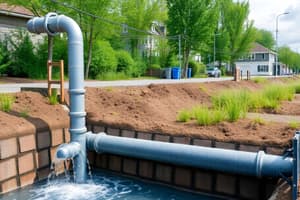Podcast
Questions and Answers
What is stormwater runoff?
What is stormwater runoff?
- Water exclusively from natural sources
- Water that soaks into the ground
- Water that flows over surfaces like streets and rooftops (correct)
- Water collected in storage tanks
Storm sewers and sanitary sewers are the same.
Storm sewers and sanitary sewers are the same.
False (B)
Name one type of pollutant found in stormwater runoff.
Name one type of pollutant found in stormwater runoff.
Oil and grease
What is the purpose of a storm runoff model?
What is the purpose of a storm runoff model?
The key components of a stormwater runoff model include volume estimation, flow rate prediction, and water quality ___.
The key components of a stormwater runoff model include volume estimation, flow rate prediction, and water quality ___.
Which factors are considered in volume estimation for stormwater runoff?
Which factors are considered in volume estimation for stormwater runoff?
Storm sewers collect stormwater runoff from inlets, catch basins, or drains located along street ___.
Storm sewers collect stormwater runoff from inlets, catch basins, or drains located along street ___.
Flashcards are hidden until you start studying
Study Notes
Introduction
- Stormwater runoff is a problem in both urban and rural areas.
- It poses a flood hazard causing millions of dollars in damage each year.
- Stormwater runoff creates environmental degradation by eroding and sedimenting lakes and streams and transporting pollutants to water bodies.
What is Storm Water Runoff?
- Stormwater runoff happens when rain flows over surfaces like rooftops, driveways, lawns, streets, parking lots, construction sites, and industrial areas.
- Buildings and pavement create impervious surfaces which prevent water from soaking into the ground.
- Storm sewers manage the large volumes of runoff by directing it to nearby water bodies.
Storm Sewers Discharge to Water Bodies
- Storm sewers are pipes laid underground below streets.
- Storm sewers collect storm water runoff from inlets, catch basins or drains located along street curbs and parking areas.
- They are separate pipes from sanitary sewers which collect wastewater and convey it to a wastewater treatment plant.
What’s in a Storm Water Runoff?
- Pollutants from streets and parking lots get washed away with storm water runoff.
- Pollutants include:
- Garbage
- Oil and grease
- Gasoline
- Sediment from construction sites and urban runoff
- Metal flakes from rusting vehicles and brakes
- Road salt
- Lawn pesticides
- Agricultural herbicides
- Heavy metals from roof shingles
- Pet waste
- Leaves and grass clippings
- Bacteria
- Nutrients
- Other chemicals
- Illicit discharges such as paints, cleaning solutions, and used motor oil.
What's the Storm Runoff Model?
- Storm runoff models simulate the behavior of rainwater or melted snow as it moves over land, through drainage systems, and into water bodies.
- Models integrate parameters like rainfall data, land cover characteristics, soil types, topography, and infrastructure details to predict the volume, timing, and pathways of runoff.
Principles
- Stormwater management involves understanding how a particular land area and drainage system can affect or be affected by storm water passing through it.
- When alterations to the land area or drainage network are planned, managers need to understand how the alteration is likely to affect the volume, flow rate, and quality of runoff.
Modeling and Stormwater Runoff
- Modeling is a tool that can be used to evaluate and understand complex processes involving stormwater runoff.
- A stormwater runoff model is needed whenever an estimate of the expected volume, rate, or quality of stormwater is desired.
Key Components of a Stormwater Runoff Model
- Volume Estimation: Calculates the total amount of stormwater runoff generated from a storm event based on factors like rainfall intensity, duration, and the surface area of impervious and pervious zones.
- Flow Rate Prediction: Estimates the speed and peak flow rate of stormwater runoff as it moves through drainage systems, streets, and natural channels. Important for preventing flooding and designing adequate stormwater infrastructure.
- Water Quality Assessment: Evaluates the types and concentrations of pollutants (e.g., sediments, nutrients, oils) that stormwater carries, helping to identify potential environmental impacts on nearby water bodies.
- Land Use and Surface Characteristics: Takes into account the type of land cover (e.g., urban, industrial, or natural areas) and surface permeability, which influence how much stormwater infiltrates the ground versus becoming runoff.
- Climate and Rainfall Data: Incorporates historical and forecasted rainfall data to predict the frequency and intensity of storms.
- Topography: Considers the elevation changes and slopes of the terrain, which affect the flow direction and velocity of stormwater runoff.
- Drainage Network: Includes details about the location, size, and connection of storm sewers, ditches, and other drainage structures.
- Infrastructure: Accounts for man-made structures such as roads, buildings, and bridges, which can influence stormwater flow and potentially create flooding hazards.
Uses for the Storm Runoff Model
- Flood forecasting: Used to predict the likelihood and severity of floods caused by excessive stormwater runoff.
- Urban planning: Used to guide the design and development of urban areas to minimize the impact of stormwater runoff.
- Water quality management: Used to identify areas where runoff is most likely to contribute to water pollution and develop strategies to mitigate these impacts.
- Environmental impact assessment: Used to evaluate the potential environmental consequences of proposed construction projects or other activities that may alter stormwater runoff patterns.
Studying That Suits You
Use AI to generate personalized quizzes and flashcards to suit your learning preferences.





